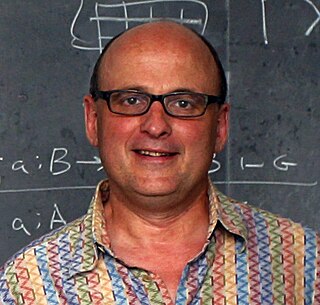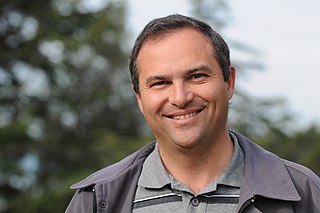Related Research Articles
In computing, a compiler is a computer program that translates computer code written in one programming language into another language. The name "compiler" is primarily used for programs that translate source code from a high-level programming language to a low-level programming language to create an executable program.
In distributed computing, a remote procedure call (RPC) is when a computer program causes a procedure (subroutine) to execute in a different address space, which is written as if it were a normal (local) procedure call, without the programmer explicitly writing the details for the remote interaction. That is, the programmer writes essentially the same code whether the subroutine is local to the executing program, or remote. This is a form of client–server interaction, typically implemented via a request–response message-passing system. In the object-oriented programming paradigm, RPCs are represented by remote method invocation (RMI). The RPC model implies a level of location transparency, namely that calling procedures are largely the same whether they are local or remote, but usually, they are not identical, so local calls can be distinguished from remote calls. Remote calls are usually orders of magnitude slower and less reliable than local calls, so distinguishing them is important.
IDL may refer to:
William Allan Wulf was an American computer scientist notable for his work in programming languages and compilers.
BLISS is a system programming language developed at Carnegie Mellon University (CMU) by W. A. Wulf, D. B. Russell, and A. N. Habermann around 1970. It was perhaps the best known system language until C debuted a few years later. Since then, C became popular and common, and BLISS faded into obscurity. When C was in its infancy, a few projects within Bell Labs debated the merits of BLISS vs. C.
Oaklisp is a portable object-oriented Scheme developed by Kevin J. Lang and Barak A. Pearlmutter while Computer Science PhD students at Carnegie Mellon University. Oaklisp uses a superset of Scheme syntax. It is based on generic operations rather than functions, and features anonymous classes, multiple inheritance, a strong error system, setters and locators for operations, and a facility for dynamic binding.
Extensible programming is a term used in computer science to describe a style of computer programming that focuses on mechanisms to extend the programming language, compiler and runtime environment. Extensible programming languages, supporting this style of programming, were an active area of work in the 1960s, but the movement was marginalized in the 1970s. Extensible programming has become a topic of renewed interest in the 21st century.

Philip Lee Wadler is a UK-based American computer scientist known for his contributions to programming language design and type theory. He is the chair of theoretical computer science at the Laboratory for Foundations of Computer Science at the School of Informatics, University of Edinburgh. He has contributed to the theory behind functional programming and the use of monads; and the designs of the purely functional language Haskell and the XQuery declarative query language. In 1984, he created the Orwell language. Wadler was involved in adding generic types to Java 5.0. He is also author of "Theorems for free!", a paper that gave rise to much research on functional language optimization.

Robert William "Bob" Harper, Jr. is a computer science professor at Carnegie Mellon University who works in programming language research. Prior to his position at Carnegie Mellon, Harper was a research fellow at the University of Edinburgh.
Jean E. Sammet was an American computer scientist who developed the FORMAC programming language in 1962. She was also one of the developers of the influential COBOL programming language.
A system architecture is the conceptual model that defines the structure, behavior, and more views of a system. An architecture description is a formal description and representation of a system, organized in a way that supports reasoning about the structures and behaviors of the system.
The Production Quality Compiler-Compiler Project was a long-term project led by William Wulf at Carnegie Mellon University to produce an industrial-strength compiler-compiler. PQCC would produce full, optimizing programming language compilers from descriptions of the programming language and the target machine. Though the goal of a fully automatic process was not realized, PQCC technology and ideas were the basis of production compilers from Intermetrics, Tartan Laboratories, and others.
A structure editor, also structured editor or projectional editor, is any document editor that is cognizant of the document's underlying structure. Structure editors can be used to edit hierarchical or marked up text, computer programs, diagrams, chemical formulas, and any other type of content with clear and well-defined structure. In contrast, a text editor is any document editor used for editing plain text files.
Hydra is an early, discontinued, capability-based, object-oriented microkernel designed to support a wide range of possible operating systems to run on it. Hydra was created as part of the C.mmp project at Carnegie-Mellon University in 1971.
LIS was a system implementation programming language designed by Jean Ichbiah, who later designed Ada.
DIANA is an intermediate language used to represent the semantics of an Ada program.

George Ciprian Necula is a Romanian computer scientist, engineer at Google, and former professor at the University of California, Berkeley who does research in the area of programming languages and software engineering, with a particular focus on software verification and formal methods. He is best known for his Ph.D. thesis work first describing proof-carrying code, a work that received the 2007 SIGPLAN Most Influential POPL Paper Award.
In computer science, region-based memory management is a type of memory management in which each allocated object is assigned to a region. A region, also called a zone, arena, area, or memory context, is a collection of allocated objects that can be efficiently reallocated or deallocated all at once. Like stack allocation, regions facilitate allocation and deallocation of memory with low overhead; but they are more flexible, allowing objects to live longer than the stack frame in which they were allocated. In typical implementations, all objects in a region are allocated in a single contiguous range of memory addresses, similarly to how stack frames are typically allocated.
Richard Thomas Snodgrass is an American computer scientist and writer and is professor emeritus at the University of Arizona. He is best known for his work on temporal databases, query language design, query optimization and evaluation, storage structures, database design, and ergalics.

Tartan Laboratories, Inc., later renamed Tartan, Inc., was an American software company founded in 1981 and based in Pittsburgh, Pennsylvania, that specialized in programming language compilers, especially for the language Ada. It was based on work initially done at Carnegie Mellon University and gradually shifted from a focus on research and contract work to being more product-oriented. It was sold to Texas Instruments in 1996. Part of it was later acquired by DDC-I in 1998.
References
- David Alex Lamb, Sharing intermediate representations: the interface description language, Ph.D. Dissertation, Carnegie-Mellon University, Department of Computer Science, 1983
- David Alex Lamb, "IDL: sharing intermediate representations", ACM Transactions on Programming Languages and Systems9:3:297-318 (July 1987)
- John Nestor, Joseph M. Newcomer, Paola Gianinni, and Donald Stone, IDL: The language and its Implementation, Prentice-Hall, 1990.
- Richard Snodgrass, The Interface Description Language: Definition and Use, W.H. Freeman, 1989
- J Nestor, William Allan. Wulf, David Alex Lamb, IDL, Interface Description Language , Technical Report, Carnegie-Mellon University, 1981